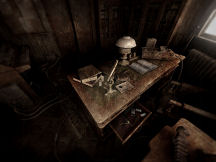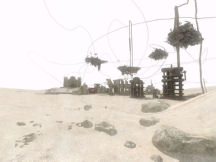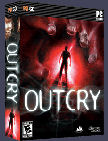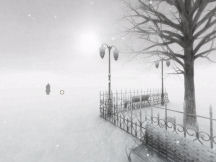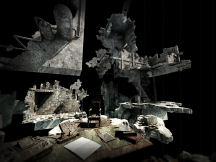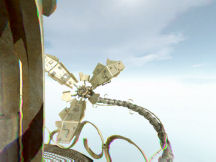Where to start? At the end perhaps, as you (or not-you)
sink into the dark and quiet water. Or at the beginning, which would seem
sensible, but which only hints at what is to come. Or somewhere
in-between, except that “in-between” is a relative concept when time and
reality are constantly distorted.
So let’s start with the music, or better yet, the sound.
“It
is known that the original destination of Music is to create grounds for
Ritual, grounds which may be supplemented by visual & audial forms.
Journey, illusory as a dream & real as a tale — it is one of those
numerous perceptions which a ritual can bring forth to you”.
So says
Anthesteria, the audio-visual project from St. Petersburg that created the
music for this particular journey. Though not referring specifically to
Outcry, it very well could be.
So too this:
I
offer you a journey. It has no exact route 'cause it lays through Past &
Dream, through Monuments of archetypes, through routine everyday
surroundings (how fascinating can it be!) & non-existing Towns. The
journey may either leave you indifferent or touch your deepest feelings
thus awakening a hunger for new places — the result is still unknown...
That is as good a summary of
Outcry as you will get anywhere.
Except you probably won’t be indifferent.
I loved this game, or rather, this whole experience.
Yes, the plot was bewildering, perhaps even nonsensical. Yes, it could be
ponderous, and at times even pompous. I agree some of the imagery was a
little “tricked up”. And no, I don’t usually like sound puzzles. As for
the characters…what characters?
But I didn’t care. Peel the layers if you will, try and
force the thing into a cohesive whole if you must. Or just go with the
flow.
Outcry1 - a strong reaction or
expression
I reckon there is a little bit (or in my case a lot) of
obsessive-compulsive in all adventure gamers. We like the fact that we can
impose order on an environment that no one but us can disturb. Fiddle
here, poke there, put it back the way it was. Leave and come back and it’s
exactly as we left it.
You can do that in Outcry, but you won’t get
order. Not in the sense that it will make sense. There are too many ideas
and thoughts, all a bit messed up. So focus on those things that you can
bring order to – the puzzles – and simply revel in the sights and the
sounds around you.
The plot is the least impressive part of the game. You
are a middle-aged writer, responding to a letter from your estranged
professorial brother. Drawn perhaps by the lure of new material for a
book, or simply intrigued by the claim that your brother has discovered
new horizons of human cognition, you arrive to find him not there and a
strange machine occupying the lounge room. His diaries and notes and
perhaps a glimpse of him here and there propel you inevitably towards the
Shimmering World that the machine will unlock.
So far so good, but it becomes overwhelmed by
philosophical musings, metaphysical ramblings, and (believe it or not)
dolmens. In there somewhere is probably an interesting treatise on the
conscious as opposed to the physical self, but it was overdone and got
lost. I stopped trying to find it, and it didn’t really matter.
I was tempted, given that getting the machine started
depends upon concocting and inhaling a plant extract, to think of the
whole thing as one big drug-induced piece of psychosis. Perhaps it was. It
doesn’t really matter.
There was also an undercurrent of things not being what
they seemed, of guilt and sadness and a fractured mind. There was
tenderness leaking through in parts, but mostly it was cold and
melancholic. The final scene is suggestive of a lot of things - a closed
loop maybe, or a Gordian twist. Or maybe by that stage I was just trying
too hard to find meaning. But in the end that didn’t matter either.
Outcry2 – a crying out
Most notes and journals will be read to you rather
excellently by a gravel-voiced actor who suited my idea of the missing
professor. He sounded like I imagined he should. There are limited other
voices, none of them nearly as good.
The musical score is stunning. Sombre, haunting, moody.
It’s a pastiche of strings and other instruments and accompaniments,
didgeridoos and Tibetan throat singing included. Turn it down only when
you get to the Harp Tower, the penultimate realm that is one big sound
puzzle. Otherwise, bask in its auditory lushness.
The puzzles are like those in games such as Rhem
or Sentinel. Find things, push things, pull things, see what
happens. Do it again, watch the cause and effect, listen. How the puzzle
works is often part of the puzzle. There are more clues in the first part
of the game than later on. In a few, the cause and effect became
irritatingly dislocated (flip a switch, go see what happened, come back
and flip another, take another look etc., etc.). They are also
self-contained to each particular location, which doesn’t make them any
less challenging but does confine the solution.
Two in particular stood out for me. Getting the tram
started in the Desert was the most multifaceted puzzle in the game, and
for me combined some good old-fashioned trial and error with some much
underutilised brain power. Its completion is rewarded by a lute-fueled
cutscene that is just about the high point of the game. Then you get to
the Harp Tower, from which you must coax life with sound. It won’t be
everyone’s cup of tea, but I confess that when I stepped outside the first
time to find I had got the first flower bud to open, I was genuinely
thrilled. Deconstructed, it isn’t as bad as it seems, at least in
retrospect. But there will be a lot of pulling and turning and striking to
understand the puzzle, at least there was for me, and remember to turn the
music off – your hearing will be far less distracted.
Some puzzles had interesting dimensions, literally and
figuratively. Once you build the time key, you can jump back and change
things for the better in your current time. Need more time? Do it again.
Then power up the right machine, and flip the world 90 degrees.
Outcry3 – a loud clamour
Then we get to the look. Outcry is visually striking,
there is no denying that.
Some of the locations are almost surreal; the first look
at the Shimmering World is almost Escher-esque -- a fragmented environment
with pieces floating past at different orientations. The Desert is one big
battery, with cables snaking across and throughout the starkness to link
hovering power cells. It too shimmers, each scene swirling and floating at
the edges of the screen.
Then the Harp, with the metallic flower buds almost
languidly draping the sky.
Other environments are less elaborate, but the “tricks”
I referred to earlier give them a different look. The professor’s house
flickers like an image from an old projector, complete with blotchiness
and picture flaws. Move from one location to another and the transition
happens as if you are looking through the shutter of a snapping camera.
And even standing still, your viewpoint wanders and sways ever so
slightly.
Call it gimmicky if you like, but it sure adds something
to the mix.
You can turn off some of these visual settings if you
don’t want them. The transitions can occur normally, and your viewpoint
can be set to indeed be still. I turned them on and off as the mood took
me.
You can play with your inventory items and reference
material (the diaries, notes, letters, etc.) and have them permanently
displayed or hidden away. A right mouse click brings them up, another one
puts them away. A door handle will also be available, which is the access
to the menu screen.
I was confused a few times as to whether or not I had
taken a book or note with me. Sometimes the books remain visible in the
game world, but have in fact been added to your collection. The close-up
view of certain puzzles also reveals details which are not apparent from
the normal view. For example, you might have laid an object on a table in
close-up view, but when you withdraw from the close-up, the table is there
but you can’t see the object.
The game world rotates 360 degrees as well as up and
down by moving the mouse to the edges of the screen. You can slow the
mouse sensitivity, and you can make the rotation faster by clicking and
holding the mouse and then dragging the rotation.
There is one short glimpse into the past of the
professor (I think that’s who it was) that involves an act of cruelty that
some players may find disturbing, and which wasn’t at all necessary.
I have already confessed my admiration for Outcry.
It will likely be a matter of taste, and even if you find it flavoursome,
there will likely be some sourness. But it’s a fair while since I played a
game of this type that I enjoyed quite so much.
P.S. According to an on-line translator, “sublustrum”
means “faintly glimmering”.
A-
September 2008
design copyright ©
2008
GameBoomers
Group
